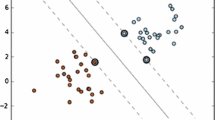Abstract
During the last few years, multiple surface classification algorithms, such as twin support vector machine (TWSVM), least squares twin support vector machine (LSTSVM) and least squares projection twin support vector machine (LSPTSVM), have attracted much attention. However, these algorithms did not consider the local geometrical structure information of training samples. To alleviate this problem, in this paper, a locality preserving projection least squares twin support vector machine (LPPLSTSVM) is presented by introducing the basic idea of the locality preserving projection into LSPTSVM. This method not only inherits the ability of TWSVM, LSTSVM and LSPTSVM for pattern classification, but also fully considers the local geometrical structure between samples and shows the local underlying discriminatory information. Experimental results conducted on both synthetic and real-world datasets illustrate the effectiveness of the proposed LPPLSTSVM method.





Similar content being viewed by others
References
Cortes C, Vapnik VN (1995) Support vector machine. Mach Learn 20(3):273–297
Vapnik VP (2000) The nature of statistical learning theory. Springer, New York (incorporated)
Osuna E, Freund R, Girosi F (1997) Training support vector machines: an application to face detection. In: Proceedings of computer vision and pattern recognition, pp 130–136
Isa D, Lee LH, Kallimani VP, Rajkumar R (2008) Text document preprocessing with the Bayes formula for classification using the support vector machine. IEEE Trans Knowl Data Eng 20(9):1264–1272
Noble WS (2004) Support vector machine applications in computational biology. In: Schölkopf B, Tsuda K, Vert JP, Istrail DS, Pevzner PA, Waterman MS (eds) Kernel methods in computational biology. MIT Press, Cambridge, pp 71–92
Zafeiriou S, Tefas A, Pitas I (2007) Minimum class variance support vector machine. IEEE Trans Image Process 16(10):2551–2564
Jayadeva R, Khemchandai S Chandra (2007) Twin support vector machine classification for pattern classification. IEEE Trans Pattern Anal Mach Intell 29(5):905–910
Chen XB, Yang J, Ye QL, Liang J (2011) Recursive projection twin support vector machine via within-class variance minimization. Pattern Recogn 44(10):2643–2655
Mangasarian OL, Wild EW (2006) Multisurface proximal support vector machine classification via generalized eigenvalues. IEEE Trans Pattern Anal Mach Intell 28(1):69–74
Fung G, Mangasarian OL (2001) Proximal support vector machine classifiers. In: Proceedings of the seventh ACM SIGKDD international conference on knowledge discovery and data mining. ACM, pp 77–86
Arun Kumar M, Gopal M (2009) Least squares twin support vector machines for pattern classification. Expert Syst Appl 36(4):7535–7543
Shao YH, Zhang CH, Wang XB, Deng NY (2011) Improvements on twin support vector machines. IEEE Trans Neural Netw 22(6):962–968
Shao YH, Wang Z, Chen WJ, Deng NY (2013) A regularization for the projection twin support vector machine. Knowl Based Syst 37:203–210
Shao YH, Deng NY, Yang ZM (2012) Least squares recursive projection twin support vector machine for classification. Pattern Recogn 45(6):2299–2307
Ding SF, Hua XP (2014) Recursive least squares projection twin support vector machines for nonlinear classification. Neurocomputing 130:3–9
Tian YJ, Qi ZQ, Ju XC, Shi Y, Liu XH (2014) Nonparallel support vector machines for pattern classification. IEEE Trans Cybern 44(7):1067–1079
Peng XJ (2011) TPMSVM: a novel twin parametric-margin support vector machine for pattern recognition. Pattern Recogn 44(10):2678–2692
Qi ZQ, Tian YJ, Shi Y (2013) Robust twin support vector machine for pattern classification. Pattern Recogn 46(1):305–316
Chen SG, Wu XJ, Zhang RF (2016) A novel twin support vector machine for binary classification problems. Neural Process Lett 263:22–35
Mehrkanoon S, Huang XL, Suykens JAK (2014) Non-parallel support vector classifiers with different loss functions. Neurocomputing 143:294–301
Xu YT, Wang LS (2014) K-nearest neighbor-based weighted twin support vector regression. Appl Intell 41(1):299–309
Hua XP, Ding SF (2015) Weighted least squares projection twin support vector machines with local information. Neurocomputing 160:228–237
Tenenbaum JB, Silva VD, Langford JC (2000) A global geometric framework for nonlinear dimensionality reduction. Science 290(5500):2319–2323
Roweis ST, Saul LK (2000) Nonlinear dimensionality reduction by locally linear embedding. Science 290(5500):2323–2326
Benkin M, Niyogi P (2003) Laplacian eigenmaps for dimensionality reduction and data representation. Neural Comput 15(6):1373–1396
He XF, Niyogi P (2003) Locality preserving projections. In: Proceedings of the conference on advances in neural information processing systems
Cai D, He XF, Han JW (2007) Semi-supervised discriminant analysis. In: Proceedings of 11th international conference on computer vision, pp 1–7
Benkin M, Niyogi P, Sindhwani V (2006) Manifold regularization: a geometric framework for learning from labeled and unlabeled examples. J Mach Learn Res 7(11):2399–2434
Wang XM, Chung FL, Wang ST (2010) On minimum class locality preserving variance support vector machine. Pattern Recogn 43(8):2753–2762
Mangasarian OL (1994) Nonlinear programming. SIAM, Philadelphia
Duda RO, Hart PE, Stork DG (2001) Pattern classification, 2nd edn. Wiley, New York
Xiong HL, Swany MNS, Ahmad MO (2005) Optimizing the kernel in the empirical feature space. IEEE Trans Neural Netw 16(2):460–474
Wang YY, Chen SC, Xue H (2011) Support vector machine incorporated with feature discrimination. Expert Syst Appl 38(10):12506–12513
Ripley BD (2008) Pattern recognition and neural networks. Cambridge University Press, Cambridge
Muphy PM, Aha DW (1992) UCI repository of machine learning databases, University of California, Irvine. http://www.ics.uci.edu/~mlearn
The USPS database. http://www.cs.nyu.edu/roweis/data.html
Nene SA, Nayar SK, Murase H (1996) Columbia object image library (COIL-20). Technical report CUCS-005096, February
Martinez AM, Benavente R (1998) The AR face database. CVC technical report #24, June
Acknowledgements
This work was partially supported by the National Natural Science Foundation of China (Grant Nos. 61702012 and 61672265), the University Outstanding Young Talent Support Project of Anhui Province of China (Grant No. gxyq2017026) and the University Natural Science Research Project of Anhui Province of China (Grant Nos. KJ2016A431, KJ2017A361 and KJ2017A368).
Author information
Authors and Affiliations
Corresponding author
Ethics declarations
Conflict of interest
The authors declare that there is no conflict of interests regarding the publication of this paper.
Rights and permissions
About this article
Cite this article
Chen, SG., Wu, XJ. & Xu, J. Locality preserving projection least squares twin support vector machine for pattern classification. Pattern Anal Applic 23, 1–13 (2020). https://doi.org/10.1007/s10044-018-0728-x
Received:
Accepted:
Published:
Issue Date:
DOI: https://doi.org/10.1007/s10044-018-0728-x




